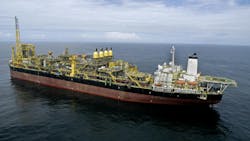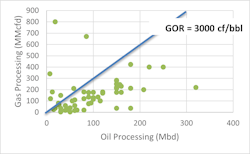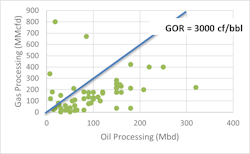FPSOs have evolved to handle more volatile crudes, gassier fields
Mark J. Kaiser, Louisiana State University, Baton Rouge
After nearly 50 years, the development of FPSO technologies represents a major success story. FPSOs have been a major enabler for the development of offshore oil and gas, and a major enabler for the development of offshore and nearshore liquefaction, storage and regasification systems.
The goal here is to classify FPSOs using the equipment gas-oil ratio and show how installations have evolved over time to handle more volatile crudes and gassier fields.
Today, the vast majority of FPSO developments are in support of black oil fields, where the fluid in the reservoir can be modeled as a single phase, black oil, rather than considering the separate behavior of oil, gas, and water. But, critical fluid and gas FPSOs have been deployed in increasing numbers.
Producing GOR
Hydrocarbon reservoirs are classified as oil reservoirs or gas reservoirs based on the relative production volume of the oil and gas streams described using the producing gas oil ratio (GOR).
Oil reservoirs are usually defined by GOR < 5,000 cf/bbl (< 23 m3/m3) and gas wells as GOR > 5,000 cf/bbl (> 23 m3/m3) using cumulative production volumes at the time of evaluation.
The wells and facilities involved in development are classified similar to the aggregate producing GOR.
Gas wells could be considered to start as low as 3,300 cf/bbl or as high as 10,000 cf/bbl, but 5,000 cf/bbl is the most common threshold, and we use 5,000 cf/bbl as the upper-bound to delineate volatile oil fields.
Here, the cut-offs are absolute, but in practice other indicators (API gravity, viscosity, C7+ volume, etc.) are needed in classifying reservoir fluids.
Equipment GOR
Since production data is not always available and is often tedious and time consuming to collect, especially internationally, a proxy for producing GOR, referred to as the equipment GOR and abbreviated E-GOR, is used to classify FPSOs as oil FPSOs and gas FPSOs.
Equipment GOR has the same units as producing GOR, cf/bbl or m3/m3, but derives from the nameplate oil and gas processing equipment capacity onboard the FPSO.
E-GOR is easy to compute because it’s based on publicly reported equipment specifications and does not require knowledge of field production.
However, it is worth mentioning that E-GOR does not track producing GOR, which is time dependent, nor is it a substitute for the measure but rather reflects the design/peak conditions of development. For classification purposes, which is not a detailed design study or engineering evaluation, E-GOR is more than adequate to distinguish between oil FPSOs and gas FPSOs.
Data source
For many years, Offshore magazine published an online poster on FPSOs that compiled all active units, available units, and units under construction at the time of publication.
The last poster was published in November/December 2022 with data reported through September 2022.
Public data sources on FPSOs may contain conflicting information, either because the original specifications have changed (i.e., upgrades) or the reported data is not correct, but no effort was made to validate the poster data.
Primary sources of information on FPSOs are current vessel specification sheets, contractor and operator web sites, academic and trade publications.
Publications always need to be used carefully because they describe FPSOs at the time of initial field development or installation, which are not necessarily the same as the current time or current field development.
Histogram
A histogram of the equipment gas-oil ratio for the FPSO active fleet is shown in Figure 1. The vast majority of FPSOs are black oil developments and about 95% of FPSOs have E-GOR < 2,500 cf/bbl.
FPSOs with E-GOR < 5,000 cf/bbl are referred to variously as oil, oil-gas, volatile oil (or critical fluid) developments, and for FPSOs with E-GOR > 5,000 cf/bbl gas, gas-condensate, or wet gas developments.
Here, E-GOR < 2,000 cf/bbl denotes black oil developments, while volatile oil developments are defined for E-GOR between 2,000 to 5,000 cf/bbl. E-GOR > 5,000 cf/bbl delineates gas field developments.
As a practical matter, it is usually far easier to distinguish between oil reservoir types (heavy oil, black oil, volatile oil) than between gas-condensate and wet gas developments because of the differences in fluid and reservoir which are only accessible to field personnel and laboratory testing.
Oil FPSOs vs. gas FPSOs
In Figure 2, active FPSOs are shown according to their oil and gas processing capacity and the year they were installed. Units are grouped by installation before the year 2000, from 2000-2009, from 2010-2022, and after 2022.
FPSOs installed before 2000 were primarily black oil developments with oil and gas processing capacity less than 100 Mbd and 100 MMcfd, respectively. Note that the triangular region between the E-GOR = 1,000 cf/bbl line and < 100 Mbd oil capacity captures most of the sample.
From 2000-2009, 69 FPSOs were installed with two volatile oil fields developed. Almost the entire sample are black oil FPSOs falling below and to the right of the E-GOR = 2000 cf/bbl line. Maximum oil capacity increased to 250 Mbd and gas processing capacity is mostly below 300 MMcfd.
From 2010-2022, 80 FPSOs were installed and a larger number of volatile oil and gas fields were developed with increases in both oil and gas processing capacities, but the vast majority of installations are still black oil developments. About a half-dozen projects during this period were gas and critical fluid developments, falling above and to the left of the 5,000 cf/bbl line.
FPSOs under construction as of 2023 show a wide spread in processing capacity and three gas field developments.
Editor's note: This article is part two of a five-part series in which Mark Kaiser examines some of the principal features of FPSO units and how they relate across the fleet. In the first part, the current inventory and lifecycle dynamics of FPSOs are reviewed.
About the Author

Mark J. Kaiser
Center for Energy Studies
Mark J. Kaiser is Professor at the Energy Institute at Louisiana State University. His research interests cover the oil, gas, and refining industry, and relate to cost assessment, fiscal analysis, infrastructure modeling, and valuation studies. Kaiser has led several studies and published extensively on decommissioning in the Gulf of Mexico. He holds a Ph.D. from Purdue University.





